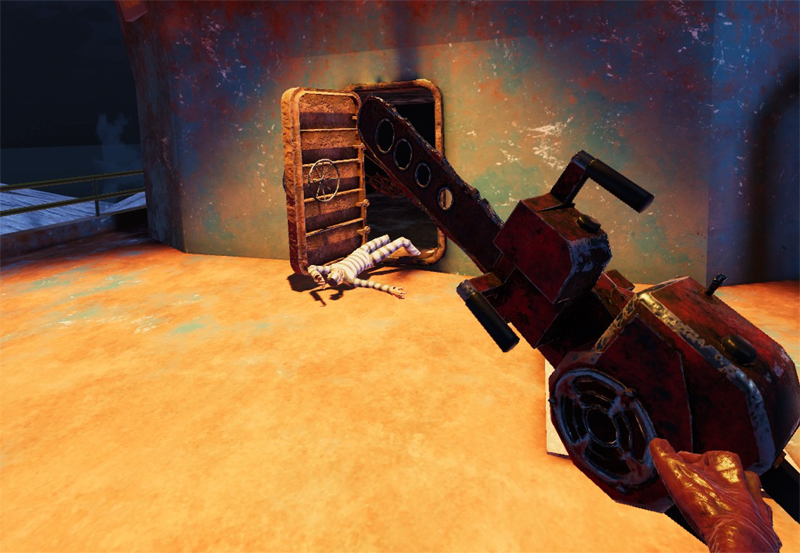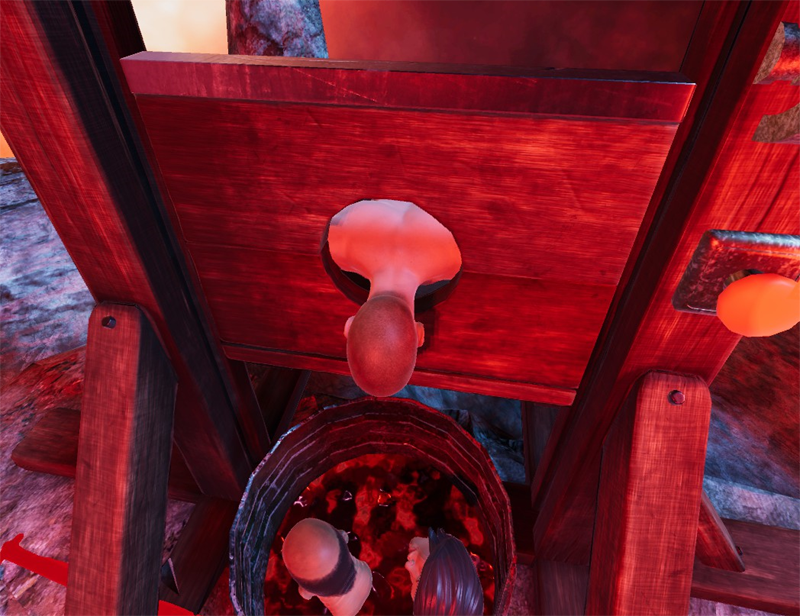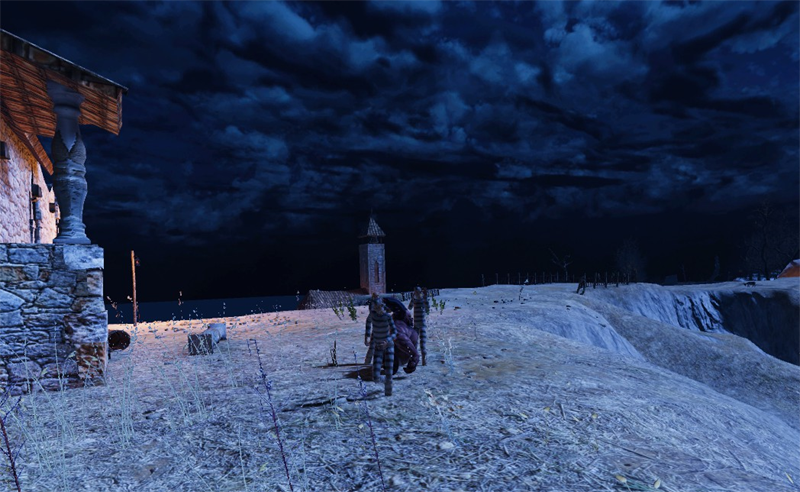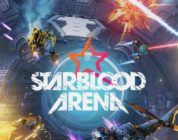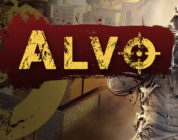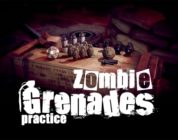Developer / Publisher – Delta Reality Misfits Village
Price – US $14.99 / EU €12.49 / UK £11.39
Release Date – May 28th, 2018
Input – Tracked Motion Controllers
Play Area – Sitting, Standing, Roomscale
Store – Steam
Reviewed on – HTC Vive
Tainted Fate is a short-yet-exciting action-adventure game with unique gimmicks, gory combat, and a low budget. You play as a demon, tired of his mundane day job endlessly decapitating humans. After a shift at work, he gets into an aggressive argument with his boss (Satan), making it all the more suspicious when he’s summoned through a portal to Earth. Finding himself on an island full of bloodthirsty prisoners and devout priests, the protagonist must uncover the circumstances behind his unintended vacation and fight his way back home.
The primary gimmick in Tainted Fate is your utterly disproportionate level of deadly force. This theme is found in every aspect of the game, but is most significant when it comes to your main combat approach. The only weapons in this game are your two bare hands, which can tear enemies apart with ease. Ripping someone’s head off is so easy that it almost feels comical- when a prisoner runs up to you, fists raised and ready to battle, just grab him by the head and it’ll pop right off. Enemy heads can be removed with such finesse that they feel similar to Lego figures. A majority of gameplay in Tainted Fate is focused around this combat tactic. Alongside Gorn, this is one of only two VR games I’ve ever played that uses dismemberment as a gameplay mechanic. This is an intuitive form of violence that could only work in virtual reality, and I’m surprised (yet disappointed) that more games don’t use it.
Grabbing enemies and casually ripping their heads off is relatively fun in Tainted Fate. This mechanic is full of issues, however. The game’s difficulty, for example, is nowhere to be found. All it takes is a brief grab-and-pull in order to kill an enemy, bosses being the only exceptions. Many games, such as Gorn, Darksiders, and Dark Souls (just to name a few examples), tease the player with mechanics that feel overpowered, before balancing enemy difficulty to match. These games pair over-the-top abilities with gameplay that’s nonetheless very difficult, leading to combat that’s highly satisfying, yet brutally tough. Tainted Fate clearly tried to fit into this niche, but falls short of being challenging.
Prisoners, demons, and priests are your only opponents outside of boss battles. Priests use ranged attacks, which travel slowly and can easily be avoided with a quick teleport. Prisoners and demons both run towards you aimlessly with their arms flailing, ready to be decapitated. The varying size of each horde is the only thing that could increase the difficulty of any given combat encounter, but doesn’t. Since it’s so easy to pull enemies apart, it doesn’t matter how many are running at you. Line them up in single-file, popping off heads one after another. If they start swarming you, just teleport a safe distance away and continue the slaughter. The size of enemy groups doesn’t actually make the game any harder, only more tedious.
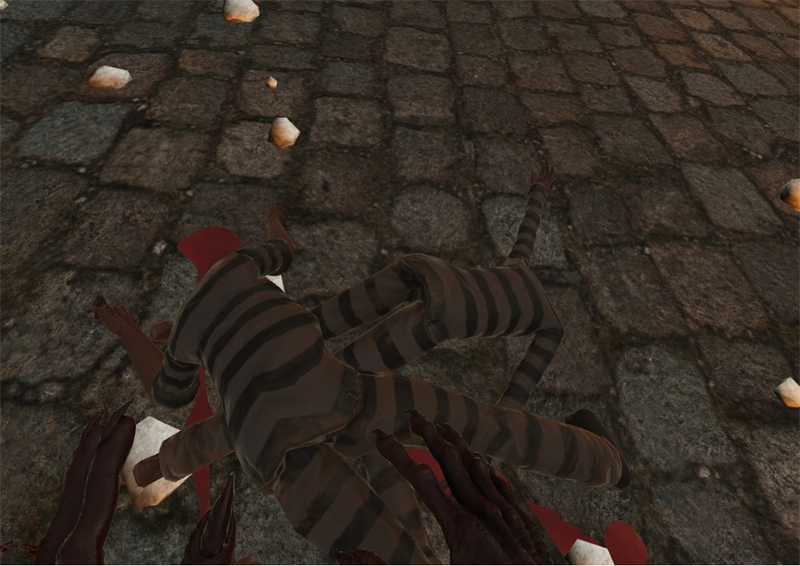
The corpses belying one of many many unearned victories
Throughout my time playing, I only died once. For a game so reliant on overpowered combat mechanics, this is where Tainted Fate sells itself frustratingly short. It doesn’t help that my only death was against a boss who your hands can’t reach. I had fun initially, carelessly tearing apart demons, basking in my sheer untouchability. I was disappointed, however, to find that the game never got any harder.
By the halfway mark, I had gotten incredibly bored. Imagine using a bottle opener to crack open a beverage, over and over again. This physical movement is nearly identical to ripping heads off in Tainted Fate, making my hands tired of such a simple motion. With an endless slew of butter-soft enemies running towards me, the motion of ripping heads off quickly became one of the most repetitive physical movements I’ve ever experienced in VR.
If dismembering enemies was actually a satisfying activity, I could forgive it for being so repetitive. Make no mistake; until the overly-easy and repetitive nature of combat became an issue, I enjoyed ripping heads off. However, when compared to the physics-driven, “stretchy” style of dismemberment in games such as Gorn, the system in Tainted Fate could have done so much better. You don’t even have to “pull apart” the enemies- all you have to do is touch them. Hold their head in one hand, their torso in the other, and the slightest movement in your hand holding the head causes it to pop right off. These enemies are literally more fragile than wet styrofoam, and it doesn’t help that the sound effect associated with decapitation sounds exactly like silly putty. Something as subtle as stretching their limbs to a certain point before tearing them off would be crucial for the experience, not only to make combat more satisfying, but also slightly more difficult.
Another issue with combat is the way enemies react to losing a limb. If someone loses their head, surely their death will be instant. Tearing off a single arm or a leg, however? Also an instant kill. For contrast, in Gorn, it feels incredibly satisfying to render an enemy paraplegic and desperately crawling towards you before bleeding out. This helps give combat in Gorn a level of brutality and depth that I wish was present in Tainted Fate, but isn’t. Just pick up an enemy, tear off any appendage, and they’re dead. This doesn’t do the game’s difficulty (or lack thereof) any justice, and maintains its status as one of the easiest VR action games I’ve ever played.
Thankfully, your industrial-strength demon claws aren’t the only tool up your sleeve. By swiping the trackpad in either direction, you can switch between one of three special abilities. None of them are all that special, but fortunately do make combat more varied. The slow-motion ability slows the passage of time to a crawl, during which you can rapidly kill everyone and watch their headless bodies collapse on the floor simultaneously. It’s hard to express how badass this feels- the first two or three times. Not only does this not change anything about the dismemberment mechanics themselves, but it makes combat even easier.
You can summon a demon ally to fight alongside you. They have low health and deal low damage, making them nowhere near as effective in combat as the protagonist. Still, they make an ideal distraction for hordes of enemies to swarm around while you prepare your massacre. Since combat is already brainlessly easy, however, distractions feel unnecessary and the demon ally is largely obsolete as a result.
Lastly, you can spawn exploding demon insects. Although they chase enemies and explode at their feet, they don’t do any damage. Rather, there are obstacles in the environment (including some surprisingly decent puzzles) that can be destroyed using these insects. This is really the only mechanic in Tainted Fate that changes gameplay in an interesting way not involving dismemberment, although their ineffectiveness against enemies is frustrating.
The story in Tainted Fate feels cliché, but is still unlike any narrative I’ve experienced in recent memory. The demon you play as is crass, obnoxious, and edgy. The lewd jokes he makes are dumb and uncreative, and his sense of humor is roughly on par with that of a 13 year-old. Even though I never found his remarks funny, or even entertaining, there’s something impressive with his personality: it fits. Within the setting, narrative, and dialogue, the protagonist’s humor never felt out of place. I wouldn’t necessarily expect a demon to have a personality like his, but for a rebellious demon with a slight identity crisis, it makes perfect sense.
Still, there are issues with the way this narrative is presented. Even though it’s simple, it’s hard to follow. Namely, it’s never easy to determine who he’s speaking to. Is he talking to himself? To Satan? To the mysterious figure who summoned him to the island? There are a number of other plot holes that regularly had me scratching my head. Why was he summoned to this specific island? Why are his fellow demons attacking him? Why is he trying to escape and return to hell, when dialogue in the introduction suggests that he’s always wanted to escape hell and visit earth? I’m not going to spoil the story or its one major plot twist, but it felt very lazy, as if the writers were last-minute adding to the story as they went along.
Tainted Fate takes place in a gloomy and depressing island. Dead trees, stormy skies, and dilapidated churches all add to the ambiance. The location sets a specific tone and mood throughout the game which fits your adventure perfectly. Tainted Fate is a semi-linear adventure game, in which every set-piece is a relevant location that will need to be explored at some point. The game’s music, which is slow and haunting during exploration sequences but transitions to death metal during combat sequences, fits very well.
Tainted Fate has extremely poor graphics. With smudged, cartoony textures and flat lighting, this game is often downright unpleasant to look at. This is why it surprises me that the environment, partly thanks to these graphics, is one of my favorite aspects of the game. The grotesque and unattractive visuals only contribute to a bleak, depressing atmosphere. It may be a cliche theme, reminiscent of an Edgar Allen Poe story, but the aesthetic in Tainted Fate’s map is even more memorable than any other aspect of its gameplay.
As you’d expect from a game with graphics like these, performance is generally smooth and without any noticeable lag. What’s surprising, however, is that loading times in this game are painfully long; I quit the game a couple times as a result of losing my patience to all the loading screens. The user interface of this game feels low-budget and isn’t anything special, but isn’t bad. The Steam store page for Tainted Fate boasts about how immersive it is due to its lack of any heads-up display. I have mixed opinions about this claim; in a game with controls as simple as Tainted Fate, there really shouldn’t be a HUD no matter what. I don’t believe this is all that exciting of a feature, and doesn’t make the game any more immersive than you would otherwise expect. However, the goal of an immersive non-HUD is successfully reflected in your abilities. When switching between abilities, different warts and cysts grow on your hands, with different colors to reflect the ability you’ve equipped. I applaud this design choice, as it ensures that there is truly no intrusive on-screen text whatsoever.
Tainted Fate took me around two hours to complete, across a varied environment with numerous boss battles. Even when the combat was boring, I found myself engaged with the adventure as a whole and never felt the urge to exit.
Overall, the level design in this game isn’t bad. The only exception were moments when you must throw a certain quota of severed heads into a hellish vat that spawns from the ground. You still get credit for throwing whole bodies in, without ripping their heads off, somehow making combat even easier. Akin to wave-based survival segments, these scenes are tiresome and serve little purpose other than filler. I also couldn’t reach the final boss battle, with a glitch in the preceding puzzle. There’s still room for Tainted Fate to improve, however, as this issue and many others are being addressed by the developers. This is an early access title, with player comments regularly being considered.
What would I pay for it? Tainted Fate is buggy, short, easy, and low-budget. It has a wide variety of issues that bog down the experience and make it feel incredibly cheap. The game’s lack of any difficulty is also a nuisance. Nonetheless, I’d be lying if I said I didn’t get some amount of fun out of playing it. The adventure is engaging, the aesthetic is memorable, and the concepts are interesting. If you purchase Tainted Fate for its asking price of $15, you will be sorely disappointed. If it were $5, however, I would consider it worth a buy. It’s not a great game, or even necessarily a good one. For a uniquely mediocre demonic adventure, I would definitely recommend picking it up on sale.

